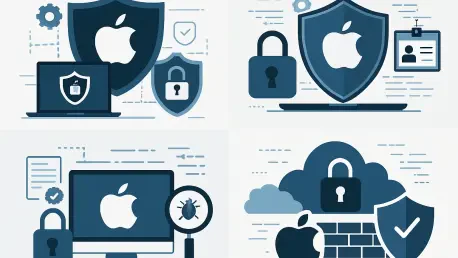In today’s fast-paced corporate technology landscape, the surge of Apple devices in enterprise settings marks a significant shift, driven by their user-friendly design and robust capabilities, but this growth also brings heightened security challenges that demand innovative solutions. Kandji, a prominent player in Apple device management, has unveiled a cutting-edge tool named Vulnerability Response, specifically engineered to fortify the security of corporate Apple hardware by accelerating the process of software updates. This development comes at a pivotal moment as businesses increasingly rely on Macs and other Apple products to power their operations, necessitating advanced tools to safeguard against ever-evolving cyber threats. With Apple carving out a larger space in the enterprise market, the introduction of such a solution underscores the urgent need for tailored security measures that can keep pace with sophisticated attacks. This article delves into how Kandji’s latest offering addresses these pressing concerns while exploring Apple’s expanding role in business environments and the collaborative efforts shaping IT management strategies.
Apple’s Expanding Footprint in Corporate Spaces
Apple’s growing presence in the enterprise sector is reshaping how businesses approach technology, with a notable uptick in Mac deployments across organizations of varying sizes. Many companies are managing substantial fleets of these devices, drawn by the intuitive user experience and productivity benefits that macOS offers over competing systems. A significant driver of this trend is the approaching end of Windows 10 support, prompting firms to evaluate alternatives like Apple’s ecosystem rather than transitioning to newer Windows versions. Additionally, economic analyses reveal that Macs often present a lower total cost of ownership over a typical three-to-four-year lifecycle compared to traditional PCs, making them a financially sound option for enterprises looking to optimize budgets without compromising on quality or performance. This shift reflects a broader recognition of Apple’s value in professional settings, where user preference and cost efficiency converge to influence strategic hardware decisions.
Beyond adoption rates, Apple has been proactive in enhancing its appeal to corporate clients through targeted updates revealed at the Worldwide Developers Conference (WWDC). Innovations such as the Device Migration tool simplify the process of switching between Mobile Device Management (MDM) systems without the need for device resets, easing transitions for IT departments. Enhancements to Platform Single Sign-On (SSO) also streamline account creation using cloud identity credentials, while new integrations through Apple Business Manager allow for seamless access to warranty data within IT Service Management (ITSM) platforms. These advancements demonstrate Apple’s commitment to addressing the unique needs of enterprise environments, ensuring that its devices are not only user-friendly but also manageable at scale. As Apple continues to refine its ecosystem, it sets the stage for specialized tools to further bolster security and operational efficiency in business contexts.
Addressing Security Risks with Advanced Tools
As Apple devices become more prevalent in corporate networks, the importance of robust security measures cannot be overstated, especially given the persistent threat of cyberattacks exploiting unpatched software vulnerabilities. Recent data highlights a sobering reality: a significant percentage of breaches stem from unaddressed security flaws, with many organizations taking over a month to implement necessary patches, leaving systems exposed to potential intrusions. Kandji’s Vulnerability Response tool emerges as a critical solution to this challenge, integrated within its MDM framework to continuously monitor applications against the latest Common Vulnerabilities and Exposures (CVE) data. By prioritizing updates based on the severity of identified threats, this tool enables IT teams to apply fixes in real time or schedule them strategically, offering a marked improvement over generic, delayed patching cycles that often fail to mitigate risks promptly.
The impact of such a tool extends beyond mere technical functionality, addressing a core vulnerability in enterprise security strategies where human error or oversight can exacerbate risks, even within Apple’s inherently secure platform. Kandji’s solution empowers administrators to customize responses to vulnerabilities, whether by enforcing immediate patches for high-severity issues or logging less critical ones for later resolution while respecting user time zones and workflows. This flexibility ensures that security measures align with operational needs, reducing disruptions while maintaining a strong defense against potential exploits. In an era where cyber threats evolve rapidly, the ability to respond dynamically to vulnerabilities positions businesses to safeguard sensitive data and maintain compliance with stringent industry standards, reinforcing trust in Apple devices as a cornerstone of enterprise technology.
Enhancing Protection Through Proactive Measures
The necessity for proactive security in enterprise environments is amplified by regulatory and compliance demands that mandate swift action on identified vulnerabilities, often within tight timeframes. Standards set by bodies like the National Institute of Standards and Technology (NIST) emphasize patching high-severity flaws within a narrow window, a requirement that many organizations struggle to meet without automated tools. Kandji’s Vulnerability Response addresses this gap by leveraging real-time threat intelligence to prioritize and execute updates, ensuring that businesses can adhere to service level agreements (SLAs) and avoid penalties or breaches. This targeted approach not only mitigates the risk of exploitation but also builds resilience into IT infrastructures, allowing companies to confidently expand their reliance on Apple hardware without fear of compromising security.
Moreover, the tool’s design acknowledges the unique challenges of managing Apple devices in diverse corporate settings, where delayed updates or user resistance can create windows of vulnerability. By automating the patching process and providing granular control over deployment, Kandji enables IT teams to minimize exposure to threats that could otherwise disrupt operations or damage reputations. This proactive stance is particularly vital as cyber attackers increasingly target endpoints, exploiting even minor lapses in security to gain access to broader networks. As businesses navigate the complexities of digital transformation, solutions like these become indispensable for maintaining a secure and efficient ecosystem, ensuring that Apple’s growing role in the enterprise is matched by equally robust protective mechanisms that safeguard both data and productivity.
Collaborative Innovation in Device Management
Apple’s ongoing advancements in device management, such as the introduction of Declarative Device Management (DDM) in forthcoming macOS releases, signal a forward-thinking approach to automating and streamlining IT processes in enterprise environments. These platform enhancements provide a foundation for third-party vendors like Kandji to build specialized tools that address specific pain points, such as vulnerability management. The synergy between Apple’s native capabilities and Kandji’s tailored solutions creates a comprehensive framework where security and usability are seamlessly integrated, reflecting a broader industry trend toward holistic device management strategies. This collaboration ensures that businesses can leverage the full potential of Apple devices while maintaining rigorous security protocols that protect against emerging threats.
Further strengthening this partnership, Kandji’s tools complement Apple’s enterprise-focused updates by offering nuanced control over security responses, filling gaps that generic platform features might overlook. For instance, while Apple’s ecosystem prioritizes seamless user experiences and broad manageability, Kandji hones in on the granular details of threat mitigation, ensuring that no vulnerability goes unaddressed. This combined effort not only enhances the overall security posture of corporate Apple deployments but also fosters an environment where IT teams can focus on strategic initiatives rather than reactive firefighting. As the enterprise landscape continues to evolve, such cooperative innovation between platform providers and specialized vendors will likely define the future of corporate IT, ensuring that technology remains both a driver of progress and a bastion of safety.
Building a Secure Future for Enterprise IT
Reflecting on the strides made in securing Apple devices within corporate spheres, Kandji’s introduction of the Vulnerability Response tool marks a significant step forward in addressing the critical need for timely software updates amidst rising cyber threats. Its ability to automate and prioritize patches based on real-time data provides businesses with a vital defense mechanism, ensuring compliance with strict security standards while minimizing operational disruptions. Apple’s simultaneous push to enhance enterprise tools through WWDC announcements further supports this progress, creating a robust ecosystem where manageability and protection go hand in hand. Looking ahead, organizations are encouraged to adopt such integrated solutions to stay ahead of evolving risks, investing in both platform advancements and specialized tools to build resilient IT infrastructures. As the landscape continues to shift, fostering collaboration between technology providers and businesses remains essential for navigating future challenges and securing the growing reliance on Apple hardware in enterprise settings.









